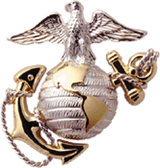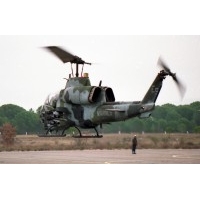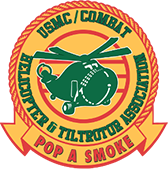
Brothers (& Sisters) Killed in Action in USMC Helicopters or while assigned to USMC Helicopter or Tiltrotor Squadrons
19960510HMM-266 HMM-266 TRAINING LOSS PREPARATION FOR COMBAT
Download PDFIncident Date 19960510 HMM-266 CH-46E - BuNo 156436 [ES-11] - - HMM-266 AH-1W - BuNo 161022 [ES-32] - - training loss over North Carolina - operating off of the USS SAIPAN
Rice, Scott T Capt Crew HMM-266 HMM-266/MAG-26/2ndMAW 1996-05-10
Kuszewski, Michael D. Major Crew HMM-266 HMM-266/MAG-26/2ndMAW 1996-05-10
[PASSENGERS]
Carroll, Sean W SSgt OB Pass HMM-266 HMM-266/MAG-26/2ndMAW 1996-05-10
Garmon, Brent W HN (Corpsman) Passenger HMM-266 HMM-266/MAG-26/2ndMAW 1996-05-10
Malagon, Jorge E LCpl Passenger HMM-266 HMM-266/MAG-26/2ndMAW 1996-05-10
Elizarraras, Jose L LCpl Passenger HMM-266 HMM-266/MAG-26/2ndMAW 1996-05-10
Chidester, Jackie D LCpl Passenger HMM-266 HMM-266/MAG-26/2ndMAW 1986-05-10
Stacy, Britt T Cpl Passenger HMM-266 HMM-266/MAG-26/2ndMAW 1996-05-10
Condello, John P LCpl Passenger HMM-266 HMM-266/MAG-26/2ndMAW 1996-05-10
Kirkland, Eric D Cpl Passenger HMM-266 HMM-266/MAG-26/2ndMAW 1996-05-10
Collins, Brian L Cpl Passenger HMM-266 HMM-266/MAG-26/2ndMAW 1996-05-10
Tucker, Brandon J Cpl Passenger HMM-266 HMM-266/MAG-26/2ndMAW 1996-05-10
Schneider, Arthur J 1stLT Passenger HMM-266 HMM-266/MAG-26/2ndMAW 1996-05-10
Fandry, Joseph R 1stLT Passenger HMM-266 HMM-266/MAG-26/2ndMAW 1996-05-10
Los Angeles Times Report
Official Defends Safety of Marine Aircraft in Crash
CAMP LEJEUNE, N.C. — As investigators began searching for reasons why two military helicopters collided during maneuvers, a Defense Department official on Saturday defended the safety of the equipment involved, which included one of the oldest type of aircraft in military service.
"These are good aircraft," said Deputy Secretary of Defense John White, who toured the crash site Saturday with senior officials. "Their safety record is very good."
White did not rule out the possibility, however, that the crash--the latest in a series of accidents involving military aircraft--may result in changes in the way training maneuvers are carried out. "It's too early to determine whether there should be changes in training," he said.
The collision occurred during nighttime maneuvers early Friday morning as a CH-46 Sea Knight transport helicopter and an AH-1 Cobra assault craft were participating in a mock amphibious landing. Fourteen people aboard the helicopters were killed, but the pilot and co-pilot of the Sea Knight craft survived.
Officials have talked with the co-pilot of the transport craft, 1st Lt. Walter W. Kulakowski of Alachua, Fla., who is listed in stable condition at the Camp Lejeune Naval Base hospital. But Lt. Gen. Charles E. Wilhelm, the commander at Camp Lejeune, said Kulakowski, 33, did not shed light on how the accident occurred.
"He was not asked any questions about the mishap itself," Wilhelm said.
The other survivor, Maj. Charles A. Johnson Jr., 33, of Fairfax, Va., was in critical condition Saturday at a hospital in Greenville, N.C.
The Cobra was assigned to fly ahead of the Sea Knight and secure a landing zone for the troop carrier. The Cobra then was to swing around as the Sea Knight approached the zone, officials said.
The CH-46 was introduced 31 years ago. Much of its equipment is obsolete and many of its spare parts are no longer made. The Marine Corps has restricted both the aircraft's speed and the number of Marines that may be carried aboard and plans to replace the helicopter with the V-22 Osprey, a tilt-rotor craft scheduled to come into the fleet in 2001.
White said the accident occurred at an altitude of 300 feet and that the pilots were wearing night-vision goggles, which can distort normal vision. He declined to speculate, however, on the role the goggles may have played in the accident.
"These people are fully qualified pilots," he said. "They wear night-vision goggles regularly."
The maneuvers were part of a U.S.-British exercise called Operation Purple Star, in which about 38,000 U.S. troops and 15,000 British troops acting as a coalition force "invade" a fictitious Third World country.
No British military personnel was involved in the mishap.
While air operations over the area were suspended just after the collision, the overall exercise is proceeding as scheduled.
The morale of the troops remained high after the accident, Wilhelm said. "They're honoring their fallen comrades and getting on with the mission," he said.
Friday's accident was the worst Marine Corps aviation disaster since a Sea Knight crashed at sea in 1989, killing 14 people.
The collision at Camp Lejeune marked the ninth time this year that Marine Corps aircraft have crashed and was the second fatal helicopter crash in two days. On Thursday, a CH-53 Super Stallion crashed during a training flight at Sikorsky Aircraft Co. in Stratford, Conn.
In March, the Corps temporarily grounded all nonessential flights to review its safety rules, but it has since resumed normal operations.
"We all would like to figure out a way to not have accidents," White said. "But, as of today, everything worked according to plan and we do not know what went wrong."
The aircraft were part of Medium Helicopter Squadron 266, stationed at nearby New River Marine Corps Air Station, and were operating from the Navy helicopter carrier Saipan, which was off the North Carolina coast.
Those killed in the collision were:
Maj. Michael D. Kuszewski, 42, of Westminster, Mass.; Capt. Scott T. Rice, 28, of Springfield, Mo.; 1st Lt. Joseph R. Fandrey, 25, of Norfolk, Mass.; 1st Lt. Arthur J. Schneider, 25, of Livingston, N.J.; Cpl. Brandon J. Tucker, 23, of Gaston, N.C.; Cpl. Brian L. Collins, 22, of Louisville, Ky.; Cpl. Britt T. Stacey, 26, of Roanoke, Va.; Cpl. Erik D. Kirkland, 29, of Lewisburg, Pa.; Lance Cpl. John P. Condello, 23, of Rochester, N.Y.; Lance Cpl. Jackie D. Chidester, 23, of Newark, Ohio; Lance Cpl. Jose L. Elizarraras, 20, of Orange, Calif.; Lance Cpl. Jorge E. Malagon; 19, of Melrose Park, Ill.; hospital nurse Brent W. Garmon, 20, of New Bern, N.C.; and Staff Sgt. Sean W. Carroll, 36, of Newburgh, N.Y.
Submitted by: Alan H Barbour, Research Historian, 20170913
New York Times article
Mid-Air Copter Collision Kills 14 Marines in South
Fourteen marines were killed and two were injured before dawn today when two helicopters collided and plunged into a densely forested marsh in an isolated part of this Marine Corps base in eastern North Carolina.
The cause of the crash, which happened at 2 A.M. during a huge American-British amphibious-assault exercise, is still under investigation, officials said.
Of the injured, one was listed in critical condition at Pitt County Memorial Hospital in Greenville and the other was listed in serious condition at the base hospital. No British troops were involved in the crash.
By midafternoon 11 bodies of the crash victims had been recovered from the scene. But it took until about 4:30 P.M. for the final 3 bodies to be recovered from the muddy and wooded area where rescuers toiled for more than 16 hours. It was an indication, a marine spokesman said, of the conditions in the forest.
The search was hampered as tractors sank up to their tread tops in the muck and rescuers resorted to cutting pathways with chainsaws and fashioning walkways over the shifting ground with slabs of plywood.
"It is very thick pine forest and swamp," said Maj. Steve Little, a spokesman. "It has been difficult, especially difficult before dawn as we began the recovery. It has been made easier with more light."
Major Little said the marines were part of a joint exercise including 38,200 American troops and 15,600 British troops. The helicopters involved were an AH-1W Super Cobra attack helicopter with a two-person crew and a CH-46E Sea Knight, an assault and transport helicopter that can carry as many as 22 people in addition to its crew of 4.
The helicopters had taken off earlier that night from ships massed off the North Carolina coast and headed inland to where the accident occurred near the Courthouse Bay boat basin at the 150,000-acre base.
Flight operations in the British-American exercises were suspended, although surface operations would continue, Major Little said.
Col. Joe C. Yannessa, commander of the rescue operation, said the collision had occurred in midair over the densely pine-forested marshland and rained debris over a 150 yard area. Colonel Yannessa said rescue crews on foot and carrying nothing more than their packs and hand-held fire extinguishers got to the section of swamp 600 yards from the nearest road within 30 minutes of the crash. There were several smoldering fires scattered throughout the area, he said.
"The aircraft frankly is in such a state of destruction that there are no identifying marks that we could see on the aircraft," Colonel Yannessa said. "They were sunk three to four to five feet into the muck."
Early efforts by Forest Service tractors to plow out a roadway to the crash scene were futile, he said, adding that they just kept sinking into the muck. Dozens of rescuers, carrying chainsaws and wearing firefighting gear and respirators, eventually made their way to the scene through the loblolly pine saplings and thick stands of swamp laurel.
In a videotape made by Marine Corps photographers as the cleanup and rescue continued late in the day, the gnarled and twisted metal of the aircraft could be seen partly submerged in the marshy loam. The camera scanned the tiny cockpit of the Cobra helicopter across an array of needle-frozen meters and gauges. Nearby a female Marine, her face flushed with exhaustion and wearing T-shirt on the hot and humid day, sat on a log.
The Sea Knight helicopter, built by Boeing and powered by General Electric engines, dates back to 1962 and was used extensively during the Vietnam War. They were most recently deployed during the Persian Gulf crisis in 1990 and 1991 war and in the evacuation of people from the United States Embassy in Mogadishu, the capital of Somalia, in 1991. But in June 1990 the entire fleet of the Sea Knight helicopters was grounded to correct mechanical problems only to be grounded again a month later to repair more problems.
The Cobra, armed with cannon and TOW missiles, dates back to 1967. It was built by Bell-Textron and powered with Avco Lycoming engines. Versions of the aircraft are also used by the Israeli military. They flew support for American ground troops during the Persian Gulf war along with the larger Apache gunships.
The aircraft and the troops were taking part in exercises in which the American and British commanders were trying to replicate the conditions of a potential Persian Gulf crisis similar to the one in 1990-1991. On Thursday Secretary of Defense William J. Perry and his British counterpart, Michael Portillo, visited the troops on the amphibious ships before they began their mock assault on the mainland during which the accident occurred.
AH1W ES-32 at Le Luc en Provence (EA-ALAT french hélicoptère airbase) 199108 Persian Gulf preparation.
Submitted by: Patrice OLIVIER, 20200801AH1W ES-32 at Le Luc en Provence (EA-ALAT french hélicoptère airbase) 199108 Persian gulf preparation.
Submitted by: Patrice OLIVIER, 20200801

